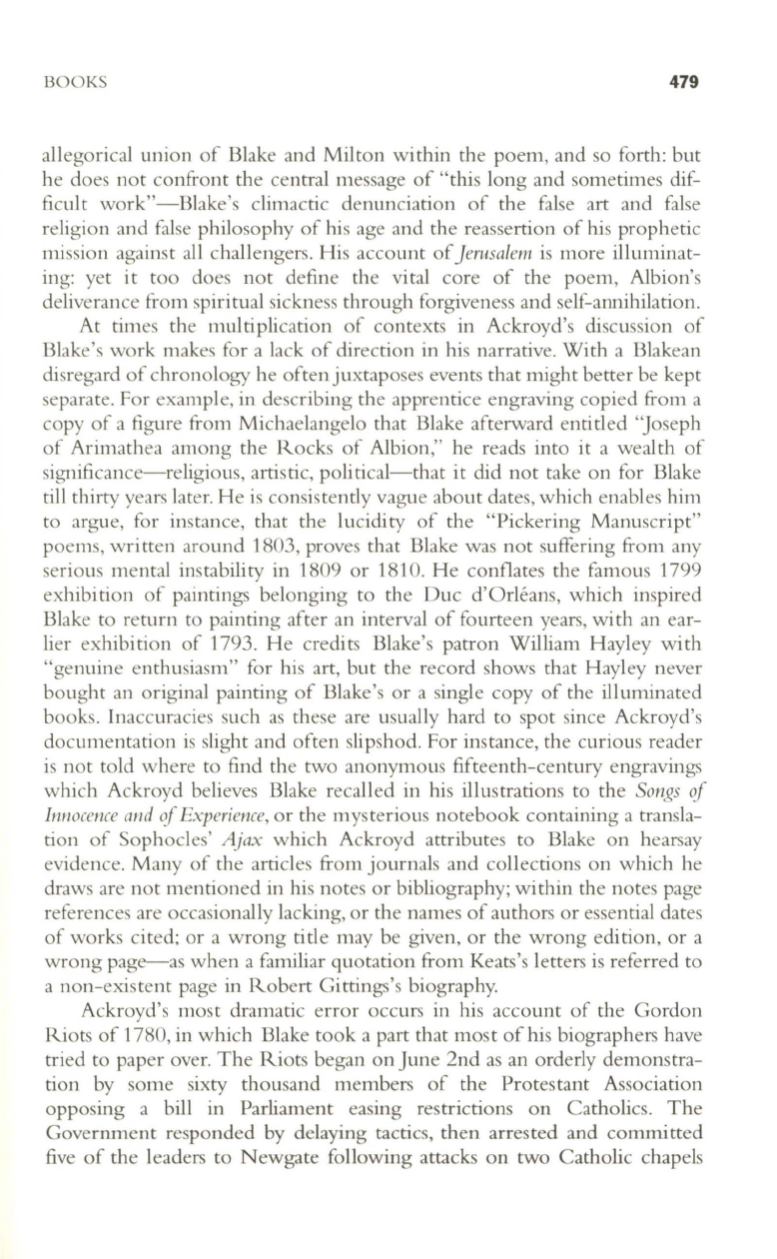
BOOKS
479
allegorical union of Blake and Milton within the poem, and so forth: but
he does not confront the central message of "this long and sometimes dif–
ficult work"-Blake's climactic denunciation of the false art and false
religion and false philosophy of his age and the reassertion of his prophetic
mission against all challengers. His account of
Jerusalem
is more illununat–
ing: yet it too does not define the vi tal core of the poem, Albion's
deliverance £i'om spiritual sickness through forgiveness and self-annihilation.
At times the multiplication of contexts in Ackroyd's discussion of
Blake's work makes for a lack of direction in his narrative. With a B1akean
disregard of chronology he often juxtaposes events that nught better be kept
separate. For example, in describing the apprentice engraving copied from a
copy of a figure from Michaelangelo that Blake afterward entitled "Joseph
of Arimathea among the Rocks of Albion," he reads into it a wealth of
significance-religious, artistic, political-that it did not take on for Blake
till thirty years later. He is consistently vague about dates, which enables him
to argue, for instance, that the lucidity of the "Pickering Manuscript"
poems, wri tten around 1803, proves that Blake was not suffering from any
serious mental instability in 1809 or 1810. He conflates the famous 1799
exhibition of paintings belonging to the Duc d'Orleans, which inspired
Blake to return to painting after an interval of fourteen years, with an ear–
lier exhibition of 1793. He credits Blake's patron William Hayley with
"genuine enthusiasm" for his art, but the record shows that Hayley never
bought an original painting of Blake's or a single copy of the illununated
books. Inaccuracies such as these are usuaJly hard to spot since Ackroyd's
documentation is slight and often slipshod. For instance, the curious reader
is not told where to find the two anonymous fifteenth-century engravings
which Ackroyd believes Blake recalled in his illustrations to the
Songs
if
Innocence alld oj Experience,
or the mysterious notebook containing a transla–
tion of Sophocles'
Ajax
which Ackroyd attributes to Blake on hearsay
evidence. Many of the articles from journals and collections on which he
draws are not mentioned in his notes or bibliography; within the notes page
references are occasionally lacking, or the names of authors or essential dates
of works cited; or a wrong title may be given, or the wrong edition, or a
wrong page-as when a fanUJiar quotation from Keats's letters is referred to
a non-existent page in Robert Gittings's biography.
Ackroyd's most dramatic error occurs in his account of the Gordon
Riots of 1780, in which Blake took a part that mos t of ills biographers have
tried to paper over. The Riots began on June 2nd as an orderly demonstra–
tion by some sixty thousand members of the Protestant Association
opposing a bill in Parliament easing restrictions on Catholics. The
Government responded by delaying tactics, then arrested and comn-utted
five of the leaders to Newgate following attacks on two Catholic chapels


